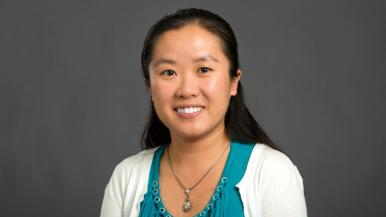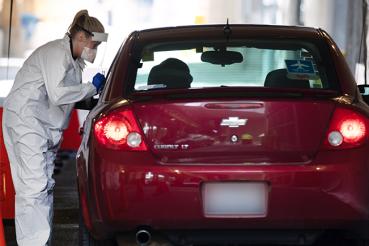Jie Li, PhD, RRT, has put in such long hours at work during the COVID-19 pandemic that she thought for a while about putting a mattress on the floor in her office so she wouldn't have to leave at all.
“I decided I did want to go home and take a shower every day,” says Li, a researcher and associate professor in the Respiratory Care program in Rush University’s College of Health Sciences.
In the frantic early days of COVID-19's long, evolving run, Li not only worked directly with patients with severe pneumonia caused by the disease but also organized a number of clinical trials to test strategies for treating those patients.
More ventilators for urgent cases
Early on, health care workers heard that thousands of clinicians were contracting the virus from symptomatic patients in China and Europe, so they put COVID-19 patients with acute hypoxic respiratory failure (AHRF) directly onto ventilators, which were limited in number and carry risks that might lead to a long recovery for patients. Clinicians made this choice because many patients did poorly on prolonged noninvasive support devices—and also out of concern that the high air flow from devices like high-flow nasal cannulas (HFNC) would propel the virus into the air, infecting others.
“Respiratory therapists are at a very high risk of infection because we care for patients who are coughing and sneezing, and on devices that disperse potentially dangerous aerosols,” Li says.
Mere weeks into the pandemic, one of Li's studies, which has been cited more than 200 times, showed that clinicians were no more likely to contract the coronavirus using HFNCs for patients than they were using low-flow nasal cannulas. She had suspected that would be the case.
That knowledge — that clinicians could safely work with patients oxygenated with HFNCs — helped free up more ventilators for patients who urgently needed them.
Expanding the use of proning
Li also helped organize an international trial that showed that patients who were “proned,” or placed on their stomachs, while “awake” — not intubated on a ventilator — might be able to avoid using a ventilator altogether. (The benefits of proning patients on ventilators had already been established.) Li’s team used an innovative, collaborative meta-trial — an agile approach that combines smaller national trials into a much larger international project in a short period — which was made possible in part by the urgency of the pandemic. Li, Stephan Ehrmann, MD, PhD, a critical care expert at CHRU in Tours, France, and other colleagues enlisted 11 principal investigators in the United States, Canada, Mexico, Ireland, Spain, and France, and enrolled altogether more than 1,100 patients in less than a year.
That study showed that proning non-intubated patients reduced the need for ventilators. The study's size expedited the publication of its findings, getting best practices for COVID-19 therapies into the clinic with breathtaking speed.
“It was a very innovative solution to deal with this problem in a very short period of time,” Li says.
One of China’s first respiratory therapists
Li, who grew up in southwest China, is the first member of her extended family to attend college. She went to a medical school in Chengdu but decided to become a respiratory therapist instead of a physician.
One major reason for that choice was that Li's grandfather died of chronic obstructive pulmonary disease when she was a teenager. While he was ill, she observed that he was not treated with inhalation therapy — only pills, “probably steroids,” even though inhalation therapy was the preferred means of care. China had no programs to train dedicated respiratory therapists before 1997, Li says; the work was handled by doctors or nurses.
She was a student in a respiratory care program when SARS, the first dangerous novel coronavirus, and the first severe emergent disease of the 21st century, broke out in China in 2003. Like SARS-CoV-2, the related virus that causes COVID-19, SARS was airborne and caused pneumonia. However, it was not as transmissible as COVID-19, and it soon waned.
“SARS made me realize the importance of this profession,” Li says.
She worked for 10 years in Beijing as one of China’s first respiratory therapists. She came to the United States for three weeks in 2005 as a visiting international fellow of the American Association of Respiratory Care. That experience gave her a chance to see an experienced respiratory service in action.
Back in China, Li hoped to help more patients than she personally was able to help, so she organized a popular annual symposium on respiratory care. In 2009, she initiated the country's first on-the-job training program for respiratory therapists, graduating 14 to 16 new therapists every six months. Often, the graduates were previously trained as nurses, she says. The program has served as a model throughout China, and the textbook she wrote for her program is widely used in the country.
“I wished I could do even more,” she says.
In 2014, she moved to Chicago to serve as clinical education coordinator and assistant professor at Rush University, in part because Rush would subsidize her pursuit of a PhD in health science if she worked full-time. She earned her degree in four years.
At Rush, Li began to conduct research. She was concerned by how little real science stood behind the treatments respiratory therapists were using every day. Soon, clinicians were contacting her to thank her for providing validity to strategies and techniques that made them more effective and confident with treatments.
“That's when I realized the importance of research,” she says.
Only months after Li finished her PhD program, friends in China began to reach out to warn her about COVID-19. “I told my colleagues, ‘It's coming,’” she says.
Even now, Li is continuing to refine best practices for addressing the grave respiratory symptoms the novel coronavirus can cause. The Lancet Respiratory Medicine recently published a meta-analysis Li led that confirms that the value of awake proning is to keep patients with moderate to severe COVID-19-related AHRF off ventilators.
Li’s team — researchers who had participated in the meta-trial, as well as new investigators in three additional countries — conducted their analysis of 29 previous studies, including 10 randomized controlled trials. Their findings showed that awake prone positioning reduced the need for intubation, especially for patients who needed advanced respiratory support — HFNCs or non-invasive ventilation — and those treated in intensive care units (ICUs). However, this meta-analysis did not find that awake prone positioning reduced mortality, the need for escalating respiratory support short of intubation, ICU admissions, ICU length of stay, or hospital length of stay. And awake prone positioning didn’t make much difference in outcomes for patients who required only conventional oxygen therapy, either.
Now clinicians will have a much clearer understanding of how to use awake prone positioning. “We are so proud of that,” Li says.
‘She outworks everyone’
In 2020, Li was named a fellow of the American Association for Respiratory Care. In 2021, she received a Young Investigator Award from the International Society for Aerosols in Medicine.
Brady Scott, PhD, RRT, a Rush colleague, says of Li, “Her work ethic is unparalleled. I work hard, I do, but she outworks me. She outworks everyone.”
Li credits Scott; David Vines, PhD, RRT, chair of the Department of Cardiopulmonary Sciences; Sara Mirza, MD, an assistant professor in pulmonary and critical care medicine; and other Rush colleagues for helping with the success of her research. She also appreciates how much she has learned from her meta-trial collaborators, especially Ehrmann.
Li says that when she was growing up her parents never pressured her to do well in school, but she saw the struggles they had in their own lives, which came partly because they weren't well educated.
“They appreciated everything that I achieved. That motivated me,” she says. “My students say, ‘You are so intelligent,’ but I'm not. I’m diligent.”




